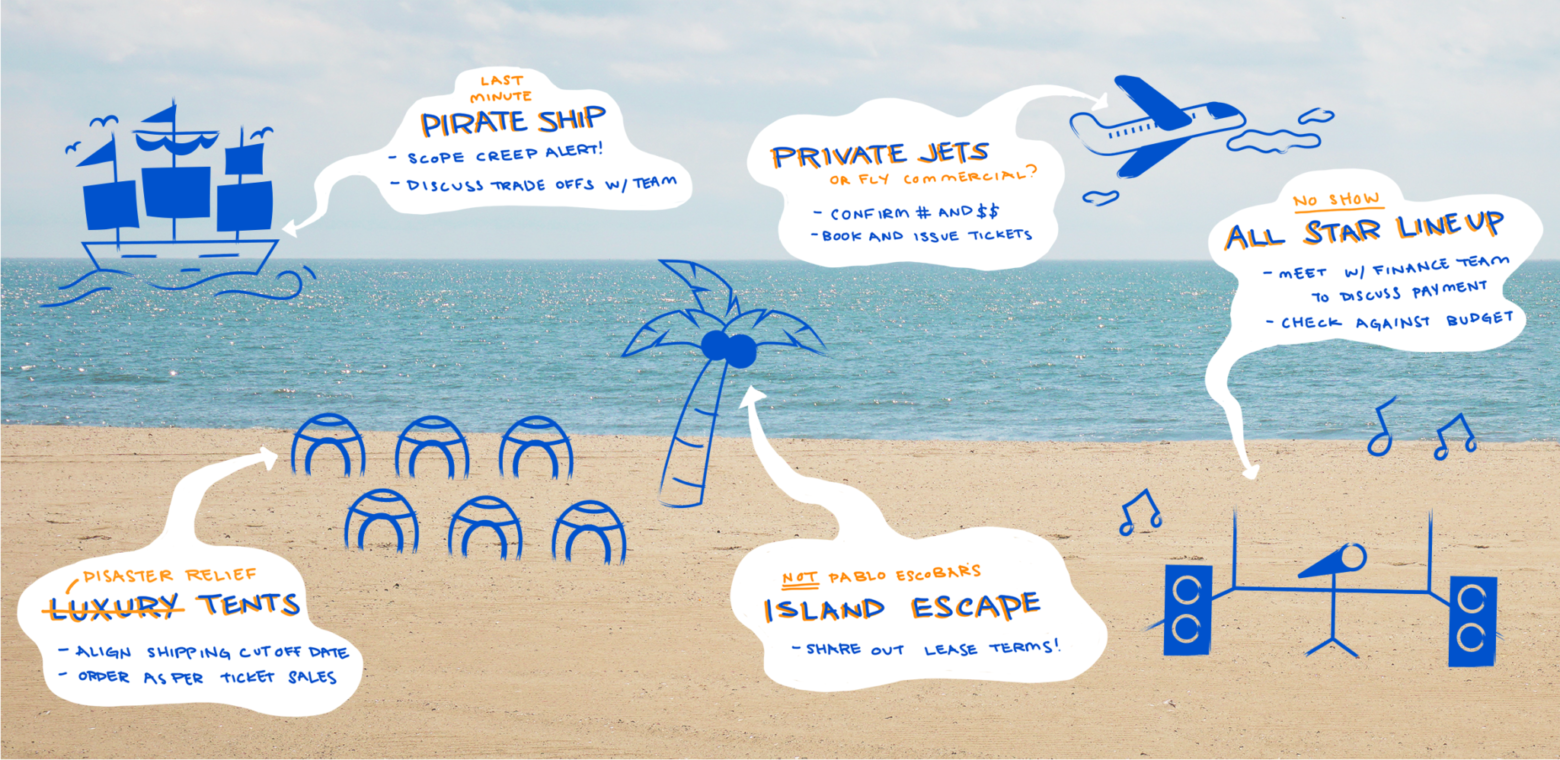For most of us, it’s a cautionary tale of epic proportions. For a program manager, the story of its downfall is a psychological thriller.
This weekend I took some time to relax and flick through some of Netflix’s awesome recommendations. Lo and behold, my top recommendation was ‘Fyre’. As a program manager that always pushes for projects to be delivered on time, this was basically a psychological thriller.
If you’re just catching up, Fyre Festival was meant to promote a new website designed to allow consumers to book celebrities for private events. It was envisioned to be a luxury music festival set in a secluded Bahamanian Island, formerly owned by Pablo Escobar, with major acts including Major Lazer and Blink 182.
Instead, people were staying on a small isthmus inside waterlogged tents left behind from a hurricane. Now clearly, expectations did not align with the reality! Attendees were out thousands of dollars each, endured a weekend in conditions that were questionable (at best) from a health and safety perspective, and the festival’s organizer is now facing four to eight years in prison.
Well once I got over the initial schadenfreude of socialites being stranded on a Bahamian beach, my brain started ticking and I realised that at its core the Fyre team needed a solid program manager.
1. Breaking down work into incremental milestones
The Fyre Festival had a clear ship date of 28 April 2018, but organisational efforts only began in earnest about two months prior. Now obviously, building a full luxury music festival village is no mean feat, from all the glamorous items like glamping tents and villas to the obvious amenities like sewage on a secluded island for 400+ people.
Vice News reports that logistical planning didn’t begin in earnest until just two months before the event. Clearly, no one was thinking about timelines and sequencing items in a logical order. For example, approximate numbers of attendees were obvious and an early architectural plan would have easily surfaced that a small island did not have the capacity for all attendees.
Any program manager worth their salt would have looked at the large scope of tasks, begun estimating their duration and then looking at what can be gated into releases or milestones for the cross-functional teams. This helps to align all the teams behind common goals, timelines and an understanding of how they are moving towards the goal.
2. Examining risks, dependencies and priorities to mitigate them
After determining appropriate milestones, an awesome program manager would have used missed milestones as triggers for review and corrective action. For example, when the original site of Norman Cay rescinded their contract and effectively kicked the event off the island two months prior.
A clear question to ask would have been, with a new site and logistics, can we even ship this festival in the remaining time? It would have been easily evident that this was a resounding no and delaying the event would have mitigated a catastrophic failure.
Furthermore, dependencies in projects are where the greatest friction occurs between teams. A good program manager would have facilitated meetings and discussions between the teams to keep them aligned on the overall goal and towards productive discussions.
3. Gluing all the information together to avoid knowledge silos
It was clear from the documentary that teams working on the core software were completely disconnected from teams working on the festival project. Furthermore, even the teams on the festival project were disconnected from each other. Marketing was selling more tickets than accounted for, finance was not issuing payment to artists signed by the booking team and so on. In the absence of milestones and collaboration mechanisms such as stand-ups, no one was thinking beyond their small allotted piece of work and therefore doubling up of work or worse yet, missing pieces of work.
Great program managers glue together all the different moving parts of the program and try to bring a broader context to teams. This allows teams to connect with each other and ensure that the overall program is successful.
4. Connecting with teams to provide safety for divergent thinking and questions
A lot of the above concerns had been flagged by various people throughout the Fyre Festival planning however they were either silenced or fired. Now obviously if the company is firing anyone who speaks out there is a greater problem at hand, but often even in open companies, people are afraid or don’t know where to speak out and express their opinions.
A good program manager ensures they provide multiple avenues for feedback and communication. From regular check-ins, facilitating meetings or maintaining an approachable and non-intimidating face for people to physically come and talk to you. The best insights come from those closest to the work and good program managers always keep their ears to the ground.
5. Asking the obvious questions
Now obviously no one in management was thinking about anything other than advertising for the longest period of time. As stated earlier, planning in earnest did not even begin until two months prior! Now such a complete failure of planning is unusual, but no one was asking the obvious: “So, when will we actually plan this festival?”
Often program managers just ask or restate the obvious, this ensures everyone is aligned on the foundational/key points of any given topics. From basic questions like, “Did we decide and agree on that?” to “Wait, how does this relate to the objective?” we constantly try and think about the overarching purpose of all interactions and strive to tie activities back to that purpose.
So… next time!
If you ever intend to organise a luxury music festival in the Bahamas or even ship a feature, think about talking to your friendly neighbourhood program manager. They’ll be more helpful than you realise.
. . .
For more hot takes on planning, meetings, and leadership check out our collection of stories designed to help you do teamwork like a boss. (And that’s no scam.)
